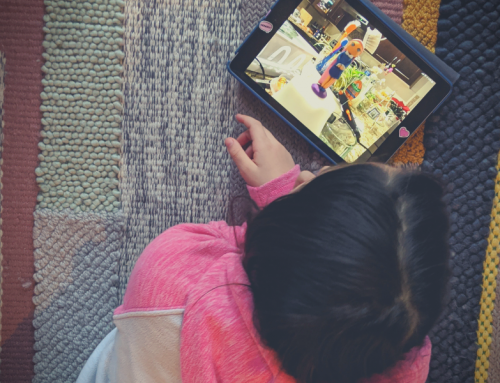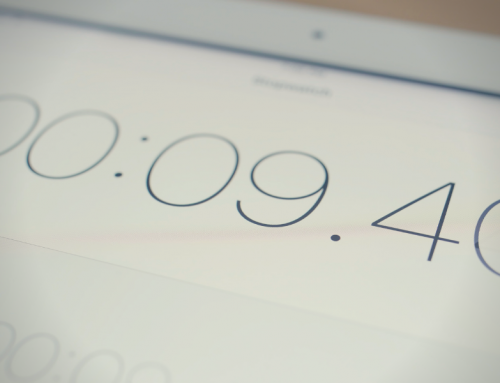There are two little words that create an outsized amount of anxiety for parents. Hearing “screen time” triggers feelings of guilt and anxiety—and googling it leads to nothing but confusion. The keywords pull up an information overload: news outlets offer up competing headlines that leave parents guessing, and experts can’t seem to agree on the actual effect of time spent with screens. As a parent—and the founder of a tech company for kids—I’ve spent a lot of time thinking about screen time, and here’s my conclusion: It’s time to scrap the term entirely. Let’s throw a retirement party for screen time, eat some cake—and then give our children the chance to have a more productive relationship with technology.
You may be wondering why I’m hung up on the semantics. Well, I believe the keywords are attached to an antiquated way of thinking about technology, and this creates real problems for busy parents. Somewhere between helping with homework and dashing to music lessons, we need to try and find reasonable, rational advice for incorporating technology into our kids’ lives—and all we get is screen time panic. As a father to two young children, I understand the struggle well. I even wrote an entire book, Screen Captured, in an effort to help parents cut through the digital noise and feel more confident about introducing tech to their kids. But how in the world did screen time become so confusing? In a search for answers, I took a look at the history of the term itself to try and figure out how it became so loaded. And, I became more convinced than ever that it’s no longer useful in the conversation about kids and technology.
What is Screen Time, Really?
Words carry meaning beyond their dictionary definitions. Whenever they’re used in writing or speech, they pick up nuance and connotation—and sometimes even end up meaning something completely different than when they started. Just look at the definition for “literally” if you need confirmation. Language is organic and ever-changing, so it’s not unusual that the words “screen time” have come to carry a lot of weight.
In his book The New Childhood: Raising Kids to Thrive in a Connected World, Jordan Shapiro dissects the term. He explains how screen time used to measure how many frames a movie star’s face appeared in a particular movie. It was something that actors wanted more of. But, according to Shapiro, the term took on a negative connotation in 1991 after Tom Engelhardt used it in an article for Mother Jones Magazine.
Engelhardt was disturbed by the way advertising, entertainment and playtime were blurring together to turn kids into consumers, and when he used screen time, he described three different things: the first refers to the total time kids spend looking at screens. The second described how corporations had begun to fix their gaze on kids, much like moviegoers look at Hollywood’s stars on the big screen. Finally, Shapiro notes how Engelhardt uses screen time to describe the “quick-cut rhythm of film editing and the race-against-the-clock urgency of a video game” that moves faster than real-time—making screen time different from how humans normally experience time.
While the first definition is a simple measurement, the second and third imply something darker. Since Engelhardt redefined screen time in 1991, it has exploded in popular usage. If you search the Google Books archive to see how often screen time appears in print, you’ll see a sharp increase beginning in that same year. Today, screen time is also a practice: a timestamp is the way that most parents and kids relate to technology, no matter the content or activity in question. And, this is deeply bound up in the words themselves.
To Panic, or Not to Panic?
“I am convinced the devil lives in our phones and is wreaking havoc on our children.” This was the New York Times quote of the day from Athena Chavarria, a former executive assistant at Facebook on October 28th, 2018. It was also used as the sub-headline in the article, “A Dark Consensus About Screens and Kids Begins to Emerge in Silicon Valley.”
This narrative—that the tech elite feel screens are overwhelmingly negative and addictive for kids—is the same one that’s often used to argue against screen time. It implies that the people who work in Silicon Valley know something nefarious that the rest of us don’t. This article begins with an ominous statement: “A wariness that has been slowly brewing is turning into a regionwide consensus: The benefits of screens as a learning tool are overblown, and the risks for addiction and stunting development seem high. The debate in Silicon Valley now is about how much exposure to phones is O.K.” Scary, right? But, with any article on screen time, it’s important to ask a few questions before overhauling your own household rules.
First, who came to this consensus? And how? In this particular article, only a handful of individuals are quoted and there are no scientific references—the evidence is qualitative, not quantitative. When you read the parent’s quotes, many are describe setting boundaries around tech use, not enforcing outright bans. And there is only one interviewee who describes screen time limits that are more restrictive than the accepted pediatric guidelines.
And, this is just one of many panic-inducing articles on the subject. Stories like this layer on top of screen time, inflaming the term and giving it the anxious quality it has today. Adding to an already-divisive debate, alarmist headlines make a confusing topic that much more frustrating for parents. Screen time puts a laser focus on measuring and restricting the duration you spend with screens, and families desperately need an approach to technology that has more nuance.
I’ve Hit My “Screen Time” Limit
I’ve written before about how screen time rhetoric has devolved to a point where there’s infighting between the experts. Parents are then left to determine whether screen time is as bad as heroin or as harmless as a potato. I believe that’s oversimplified on both counts—and I think the term screen time has accrued so much baggage that it’s time to move on from it entirely. It’s time to give families a different way to think and talk about screens in their homes.
The more we learn about technology, the more we realize that screen time is missing the mark. Just think of all the different things kids can do with technology: connect with far-away family, read books, write code, design and create works of art, cultivate their interests and pursue their passions. These are beneficial activities, but the practice of screen time-stamping treats all of those things the same way it treats scrolling social media or watching #fail videos.
Dr. Max Davie is the Officer for Health Improvement at the Royal College of Paediatrics and Child Health. He described some of the drawbacks to time-stamping technology, going so far as to call it a fool’s errand. But what should parents do instead? According to Dr. Davie, they should “ask if their child is engaging in these very compelling activities to the detriment and exclusion of the things that you as a family want to do.” As a parent, when I read something like that, I see a glimmer of hope. I see a more fruitful way to look at technology that centers on balance.
A New Proposition
When you really dig into about screen time guidelines out there, most of them aren’t warning us about the screens themselves. They are warning us about obesity, eyesight problems, interrupted sleep, impaired cognition. They make us afraid of the negative outcome, but that only happens when screen time is out of balance with other areas of our lives.
Instead of focusing on duration, we should think more critically about what kids are doing on screens—and think of screen activities in the broader context of a kid’s life. We need to pay attention to whether or not it’s detracting from other things in their lives. For me, there’s a difference between positive, skill-building screen time and the manipulative mechanisms by which kids become screen captured. Three hours spent learning to write code shouldn’t be treated the same way as three hours on TikTok. That’s just illogical—and that’s where screen time fails us.
Lately, I’ve seen a growing momentum to look at the nuance of time spent with technology. A global pandemic changed the way we look at screen time almost overnight, and now there’s a growing number of articles interrogating the effectiveness of screen time limits. When school, work and socializing all shifted online, our relationship to (and appreciation for) screens changed. It’s time to acknowledge all the positive things that come with technology and find a way to strike a screen-life balance. And at the very least, it’s time to retire screen time, pack away all that baggage and start fresh with a more productive conversation.






